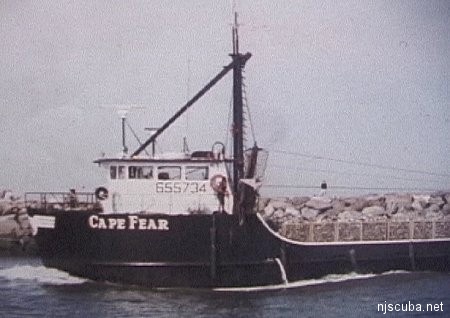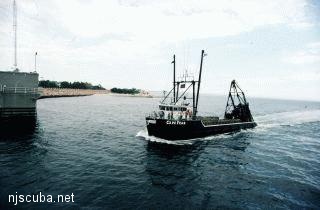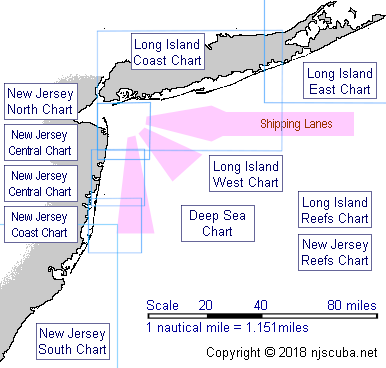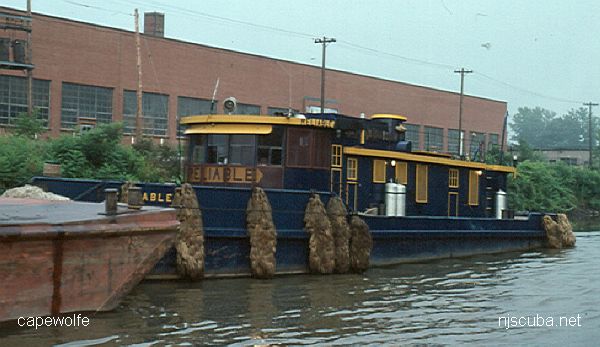Lost At Sea (5/9)
Cape Fear Sets Out as a Gale Looms

NEW BEDFORD, Mass. - Steven Craig Novack steered his 112-foot clam dredger, Cape Fear, through the drawbridge in this gritty New England seaport at 3:15 p.m. on Thursday, Jan. 7, 1999, and steamed toward the open ocean beyond Buzzards Bay, having learned on the docks that the Beth Dee Bob was down.
That news struck close to home. Novack, 36, knew the skipper of the 84-foot Beth Dee Bob. Although Edward McLaughlin, also 36, sailed from Point Pleasant, N.J., 200 miles southwest of New Bedford, he and Novack were members of the tiny fraternity of clam-boat captains.
On the entire East Coast, there were only 48 clam boats on the water on Jan. 6, 1999. Now, a day later, there were 47 boats and as many skippers, for McLaughlin was lost at sea. One of his crewmen, plucked from the frigid Atlantic the night before, was pronounced dead. The two others were missing with McLaughlin.
Unfazed, Novack headed toward the same waters in the dwindling winter afternoon. A day before, he had retreated to port without dredging any quahogs when he saw the nastiness of the ocean that would claim the Beth Dee Bob. Now, on Thursday, the forecast was for moderate winds and seas for the next 24 hours, followed by a gale at midnight Friday.
Novack, like McLaughlin, had 17 years at sea, and he had skippered eight fishing boats. Experience taught him that he could dredge his full load of 4,160 bushels of quahogs and be home before the gale struck. He couldn't go far offshore, so he settled for a patch of ocean 26 miles from the dock. At 7 p.m., within sight of the glow from Newport, R.I., to the north, Novack lowered his dredge for the first time. Beneath him was one of the finest clam boats in the fleet. And, in the mind of the boat's owner, Warren Alexander, Novack had enough on-the-job training to qualify him to run that million-dollar vessel. The skipper had little to fear.
Only 25 hours earlier, the Beth Dee Bob, also a state-of-the-art clam dredger, had gone down in minutes about 14 miles off Point Pleasant with 114 tons of quahogs - 67 cages weighing 3,400 pounds each - that it was bringing to port after what was supposed to be a 36-hour trip 70 miles out. The Coast Guard had received an emergency signal from the boat just before 6 p.m. Wednesday. About 7 p.m., Coast Guard rescue swimmer Richard Gladish loaded the nearly frozen body of McLaughlin's crewman into the basket of a helicopter and then waited in the dark ocean for 10 minutes before being picked up by a Coast Guard boat. On Thursday morning, helicopters and C-130 aircraft continued searching the ocean, accompanied by several Coast Guard boats and commercial fishing boats.
The first debris - an oil slick - was spotted then. About the same time, a helicopter flying over the Atlantic located one empty life raft, and the scallop boat Christian & Alexa found another. The search went on into Friday. It would be Sunday before Anna Puglisi conducted her own search, rummaging through a Point Pleasant motel room across Channel Drive from the clam dock, gathering the belongings of her mate of 13 years, Grady Gene Coltrain, presumed to be lost at sea on the Beth Dee Bob.
She discovered in that simple room a composition book with new poems from his hand, a big, rugged hand that worked summers on clam boats and most winters in carpentry. Their life together had its ups and downs. In one poem written earlier, Coltrain expressed his sadness over one of their low points. "Long ago you gave your love to me. Like a fool I could not see ... How much that meant until all that love I spent ... wasted it like a fool with his gold ... Now I'm left lonely and cold ..." Coltrain, 39, a native of Virginia, had worked all his adult life on boats. Puglisi never grew accustomed to his vocation. "You've got hands of gold. You can build anything. Why put your life at risk?" she would ask.
There were many good times for Puglisi to remember as she sorted through Coltrain's stuff in the motel room, where he would flop between trips. During the holidays, they did last-minute Christmas shopping and spent New Year's Eve together. It was, as well, a time filled with the little things that made her love Coltrain - the way he'd play soccer with their son, Justin, or walk the family dog, Remington. For these things, Puglisi accepted Coltrain's insistence on fishing. She knew he loved the sea and could not tolerate confined spaces. When he died, he always said, he wanted to be buried at sea.
The clam dock, a white-and-turquoise concrete block structure, was about 100 yards from the motel. Cranes snatched loaded clam cages from boats and put empty cages back in their holds and on their decks. The captains bought diesel fuel here. They made arrangements through the dock manager and his wife for trucks to haul their clams to processing plants in Cape May and Delaware, Rhode Island and Massachusetts. And when the weather was "snotty, " the clam boats with their towering superstructures and outriggers and dredge ramps remained tied to the pilings along the dock.
The Adriatic, the boat on which Michael Hager was the first mate, had been tied to nearby pilings since Dec. 15. It listed sharply to port as welders worked in its belly, installing a new clam pump. Hager, 31, his once shoulder-length sandy curls now hacked off, a baseball cap pulled low to his ears in the January cold, worked for his skipper, George Evans, 51, doing maintenance on the boat. The weekly pay was much less than his share from one day of clamming, but Hager was getting to spend more time with Mikey, his 5-year-old son, who was his life. When someone mentioned his lost trip on the Beth Dee Bob, the one when the boat sank, Hager got a faraway, somber look and spoke in amazement of still having that life.
By Friday, the Coast Guard had found no survivors from the Beth Dee Bob, and at 6 p.m. announced that it had suspended its search.
A half-hour later, off the coast of Massachusetts, the Cape Fear's dredge came up the final time. The boat turned toward New Bedford, 26 miles to the northeast, with winds blowing 20 to 30 knots from the southeast, a precursor of the gale that had been forecast. Novack had filled his hold with 90 cages of quahogs, put 24 more cages on the deck and 16 final cages on the hatch lids, for a total of 130 cages. A naval architect who had conducted stability tests on the Cape Fear had said the boat would remain safe with a maximum of 120 cages on board.
Novack believed loading quahogs was just a matter of common sense. So in 1996, when the Cape Fear was cut in two and extended by 20 feet, he went back to sea and ignored the architect's instructions. He started with smaller loads than allowed and increased his haul by increments until he reached a point where the boat felt right. That happened to be 10 cages above the limit imposed in the architect's stability letter, a document at which, in truth, he had only glanced. Moreover, as an inquiry would later reveal, the captain never followed regulations that required his crew to practice getting into survival suits. Instead, they would merely talk about safety procedures.
As the Cape Fear steamed toward port, Novack, who had an athletic build, shoulder length-blond hair and a bristly moustache, was in the wheelhouse. First mate James Haley, 35, slept in a bunk below. The other crewmen - Steven Reeves, 29, who had been with Novack 18 months, and Paul Martin, 35, and Joseph Lemieux, 28, who both had been aboard six months - were with Novack.
The wheelhouse was filled with lighthearted joking as the autopilot steered the Cape Fear flawlessly toward the calmer waters of Buzzards Bay. Waves running six to eight feet washed from the boat's starboard side across the low deck and the clam hold covers. The water then drained off the deck through scupper holes along the boat's side. The last clam-hold cover was open half a foot. Novack, who could watch his lighted deck through the rear wheelhouse windows, was unconcerned. Pumps were running to siphon seas that fell into the hold, he believed. By watching the video monitors in the wheelhouse, he knew that the engine room was dry, as well.
About 7:45 p.m., an alarm sounded, indicating water in the hydraulic room at the rear of the boat. Novack investigated and found nothing. He knew that as little as five gallons of water sloshing on the floor there could trigger the alarm. He returned to the wheelhouse after also checking the engine room and seeing no problems. About 15 minutes later, at 8 p.m., Novack and his crew saw one wave wash across the Cape Fear's 24-foot-wide stern. The seawater stayed there. The captain was puzzled and concerned.

Slowly, the water began to edge forward along the deck, the rear of the boat settling evenly into the sea. Novack, who had pulled the throttle back to idle so that the Cape Fear rode quietly, told Martin to go below and rouse Haley. The first mate was often grumpy when his sleep was disturbed, but Novack, uncertain what was happening, wanted all hands on deck. When Haley got to the wheelhouse, he saw Novack already stepping into his red neoprene survival suit, and Joe Lemieux, who could not swim, fully dressed. Haley dashed back down the ladder but found Martin climbing into a suit, taking up most of the room. Haley grabbed a suit and stepped out onto the deck to dress.
In a minute, about the time it takes to fully don a survival suit, everyone was in the wheelhouse, and the boat had begun to list to the port side, with the water advancing from the rear toward the wheelhouse. Novack, his suit up around his waist, had a million things running through his mind when he realized he should call for help. He grabbed a radio microphone and hailed the Misty Dawn, another clam boat in Warren Alexander's fleet that was about a mile ahead.
"Hey, Jack, I think we have got a problem here, " he told John Mathis Jr., the Misty Dawn skipper. "If you get a chance, can you turn around and come check on us?" Moments later, Novack asked Mathis to sound a Mayday. Then Novack ordered his crew out of the wheelhouse. The boat was rolling to port as they stepped out and ran up the tilted starboard deck. It lurched, and they were thrown back against the wheelhouse. "We've got to get off the boat now!" Novack yelled. Then he climbed over the bulwark, as did Reeves, and they slid down the hull. Haley and Lemieux tried to follow, but the boat's roll threw them back, and they landed in the 37-degree nighttime sea on the far side from Novack.
The waves were chaotic. The noise was confusing. The Cape Fear's engine still rumbled, but at the same time, geysers of air and foam shot from the sinking hull, and the once-brilliant deck lights, which glowed for a moment under water, went out. Then there was quiet, except for the desperate screams of five men lost in the heaving, freezing darkness.


